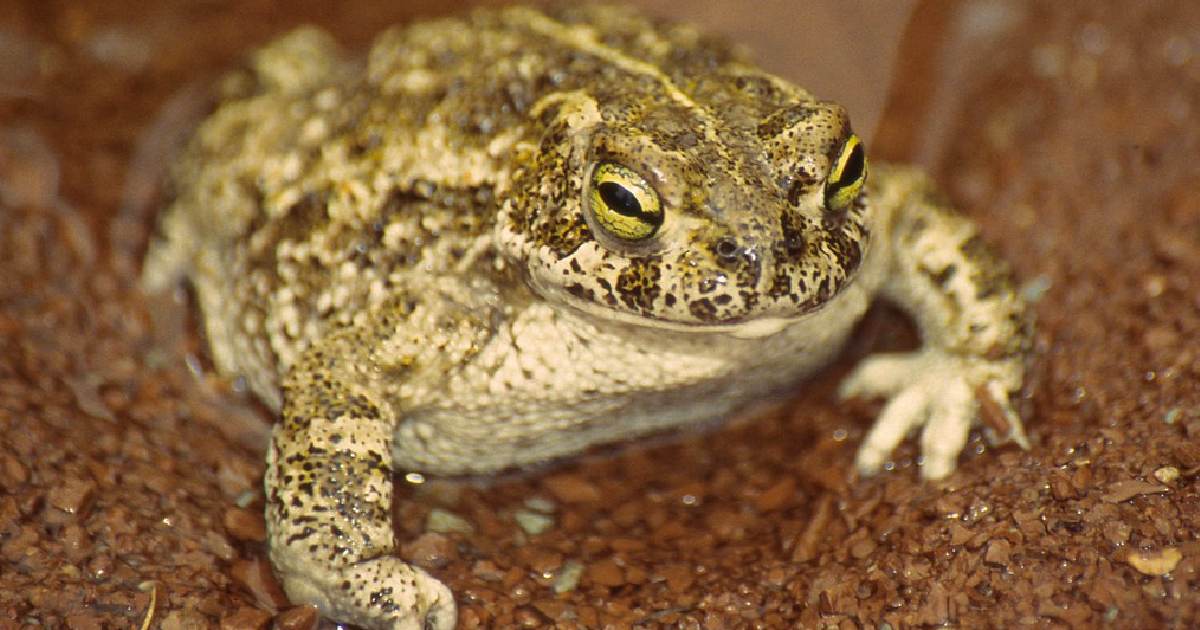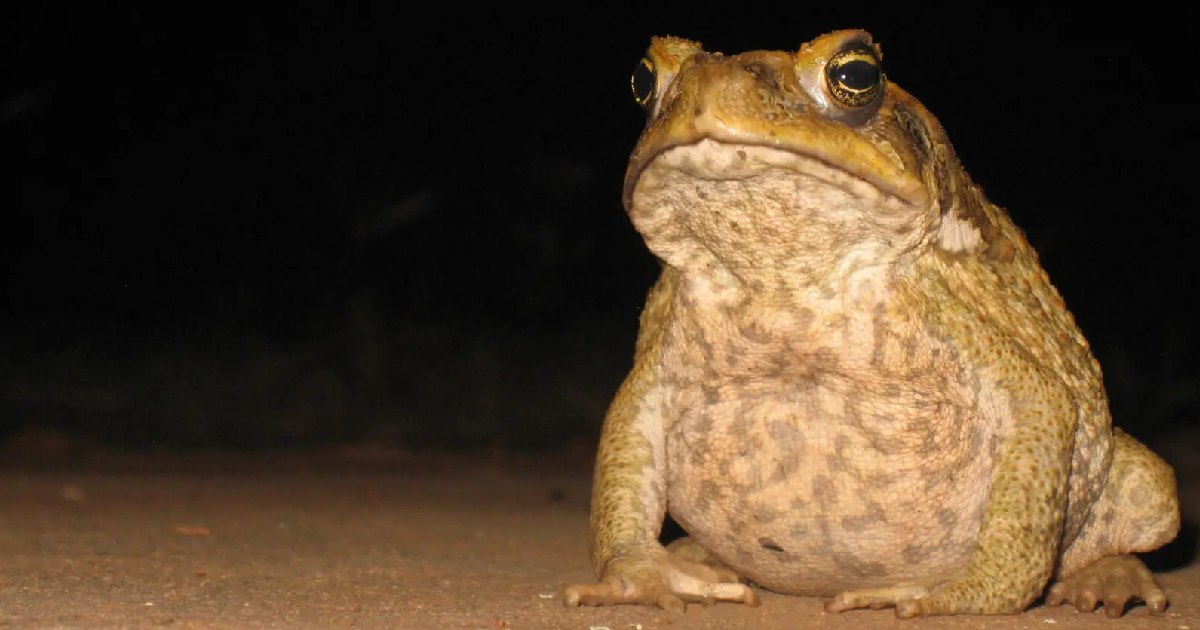Toads are remarkable wildlife that play crucial roles in ecosystems across the world. They’re distinguished by warty flesh and peculiar cries. There are species that reach tremendous sizes and develop into the biggest toads in the world. Both amphibian giants that inhabit rainforests and dunes are flexible and resilient. Each of the most fascinating toad species are speculated in in this article, including their distinctive features and roles in the world of nature.
5. Natterjack Toad

- Size: Up to 4 inches (10 cm)
- Weight: Up to 0.08 pounds (35 g)
- Key Features: Distinctive yellow stripe down the back, loud and long-lasting calls, primarily found in Europe
The European Natterjack Toad is significant for its yellow-back stripe and loud cries. The loose soil enables this plant to forage on dry heaths, sandy beaches, and meadows. Natterjacks can cope with difficult locations despite their petite stature relative to other substantial toads.
The evening toad hunt for beetles and other critters is their primary leisure pastime. Throughout the breeding cycle, males employ far-reaching cries to seduce females. Natterjack Toads belong to the biggest toads, but their peculiar shape and dominant noises render them prominent in their native habitat.
4. King Toads
- Size: Up to 6 inches (15 cm)
- Weight: Up to 1.5 pounds (0.7 kg)
- Key Features: Large size, native to the Andes, known for their robust build
In South America, the rugged locales of the Andes are home to king toads, referred to as Andean toads. These huge, robust toads develop in high-altitude areas wherein little amphibians survive. They prosper in the harsh surroundings due to their warty skin and slender limbs.
King toads are essential to ecosystems as bug predators and forage for bigger creatures. They are potent. Nonetheless, declining ecosystems and contamination put their survival in jeopardy. Protecting these noteworthy toads and their unique habitats is indispensable.
3. Monster Toad
- Size: Up to 13 inches (33 cm)
- Weight: Up to 6 pounds (2.7 kg)
- Key Features: Record size, discovered in Conway National Park, can live up to 15 years
In Conway National Park, Queensland, park ranger Kylee Gray discovered a massive cane toad that became widely shared. This 13-inch “Monster Toad” measured roughly 6 pounds and is considered among the largest ever tracked. Its scale is exceptional due to plentiful resources and favorable conditions of life.
Since these toads could potentially damage native species, park rangers like Kylee Gray have closely track and control populations. The Monster Toad exploration underscores the need to eliminate noxious plants to protect native plants and animals. Under appropriate conditions, such organisms can expand to incredible proportions like this behemoth.
2. Cane Toads

- Size: Up to 10 inches (25 cm)
- Weight: Up to 5 pounds (2.3 kg)
- Key Features: Invasive species, toxic glands, introduced to control pests
The Giant Cane Toad, also known as “Toadzilla,” is one of the largest toads in the world. In the 1930s, these colossal amphibians from Central and South America were transported to Australia to eliminate the cane beetle population. As a result of their rapid growth and catastrophic incision in northern Australia, they have turned into an ecological hazard.
Giant Cane Toads may reach 10 feet long and 5 pounds or more. Their insatiable hunger and toxic glands enable them to eat small mammals and reptiles, rendering them unfavorable to carnivores and pets. The Queensland Museum, Queensland Department of Environment, and park rangers are tracking their population to reduce their adverse impact on native animals
1. Devil Toads
- Size: Up to 16 inches (40 cm)
- Weight: Up to 10 pounds (4.5 kg)
- Key Features: Extinct species, powerful jaws, native to prehistoric Madagascar
Around 70 million years ago, Madagascar was the residence of the Devil Toad or Beelzebufo. The largest one this toad got had been 16 inches long and dropped up to 10 pounds. The creature’s body was rigid and maintained, and its jaws were powerful enough to crush tiny mammals and baby reptiles.
Dead Devil Toad fossils provide insight into amphibian phylogeny and prehistoric landscapes. This toad’s menacing name stems from growing extremely big and enjoying eating other animals. It’s an emblem of the many distinct and occasionally deadly species that used to exist on Earth.
Conclusion
The largest toads in the world are remarkable creatures that highlight amphibians’ incredible diversity and adaptability. From the invasive cane toads of Australia to the extinct giants of prehistoric Madagascar, these toads play essential roles in their ecosystems, often serving as predators and prey. However, they also remind us of the delicate balance of nature and the impact human actions can have on the environment. As we continue to study and protect these amphibians, it is crucial to remember the lessons they teach us about resilience, adaptability, and the need for conservation.
Frequently Asked Questions (FAQs)
How big was the Devil Toad?
The Devil Toad, also known as Beelzebufo ampinga, was estimated to grow up to 16 inches (40 cm) in length and weigh around 10 pounds (4.5 kg). This prehistoric toad lived during the Cretaceous period in Madagascar and was one of the largest amphibians ever known, earning the nickname “frog from hell” for its impressive size and predatory nature.
Do devil toads still exist?
No, Devil Toads, or Beelzebufo ampinga, do not exist today. They were a prehistoric species that lived during the Cretaceous period and are now extinct. Fossils of this massive toad have been found in Madagascar, providing valuable insights into the diversity and evolution of ancient amphibians, but no living descendants are known to exist.
How big is a king toad?
King Toads, also known as Bufo asper or River Toads, can grow up to 7 inches (18 cm) in length and weigh up to 2 pounds (0.9 kg). They are one of the larger toad species in Southeast Asia, preferring forested habitats and riverbanks. Their robust bodies and powerful legs make them well-adapted to their environment, where they play a vital role in controlling insect populations.
What is the largest toad that ever lived?
The largest toad that ever lived was the Devil Toad, or Beelzebufo ampinga, from the Cretaceous period. It could grow up to 16 inches (40 cm) long and weigh around 10 pounds (4.5 kg). This prehistoric toad, discovered in Madagascar, was a formidable predator capable of preying on small dinosaurs, making it the largest known toad species in history.
What is the loudest toad?
The Natterjack Toad is known as one of the loudest toads. Males have a distinctive, long-lasting call that can be heard over long distances, especially during the breeding season. Their loud and persistent vocalizations are used to attract females and can be heard in the sandy heaths and coastal dunes of Europe, where they are commonly found.

